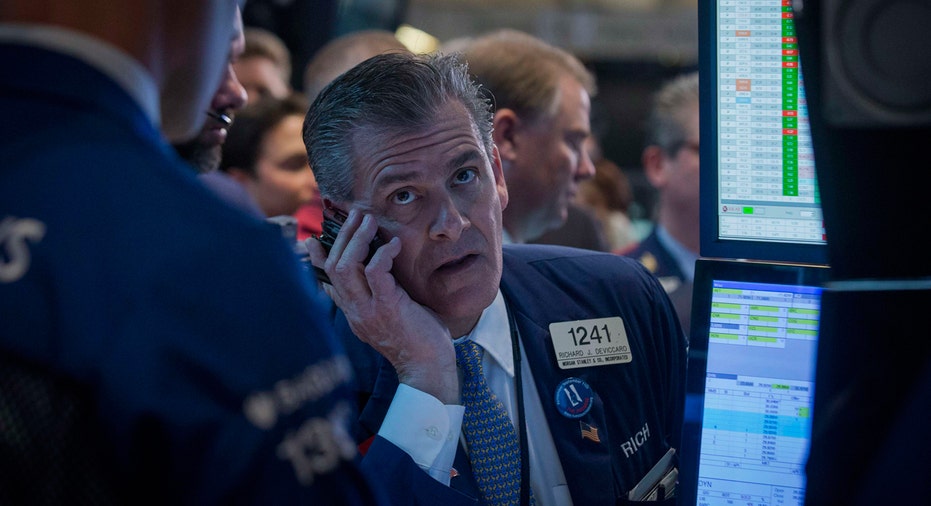Wall Street Sinks After ECB Decision as U.S. Rate Hike Looms

U.S. equity markets capped a volatile session in solidly negative territory as investors had plenty of economic headlines to digest, both on a global and domestic scale.
The Dow Jones Industrial Average was down 250 points, or 1.42% to 17478. The S&P 500 slid 29 points, or 1.43% to 2049, while the Nasdaq Composite declined 85 points, or 1.67% to 5037.
All 10 S&P 500 sectors were in negative territory as energy and health care declined the most.
Today’s Markets
Despite turning briefly positive, Wall Street extended earlier losses on Thursday as investors reacted to a morning monetary policy decision from the European Central Bank, which sent the euro surging and global equities plunging.
As had been expected, the ECB further slashed its deposit rate by 10 basis points to -0.30% while it held its benchmark refinancing rate steady at 0.05%. ECB President Mario Draghi, at a press conference in Frankfurt, Germany following the decision, said the central bank will extend its asset-purchase program through March 2017 or beyond if it becomes necessary. Draghi has vowed to do “whatever it takes” to prevent a bigger deflationary situation in the eurozone as unemployment nears its highest level since 2009.
“The ECB has a history of not acting strongly enough, but we’re getting close to a point where there will be overreaction [from the central bank] and that’s why the markets are struggling. They like the notion of more stimulus, but we’ve seen where that can lead,” Commonwealth’s Chief Investment Officer Brad McMillan said.
The move from the ECB proved to be a shock to investors who bet the dollar rally would continue. Following the policy decision, the euro spiked to $1.097, up 3.33% against the U.S. dollar. The greenback, meanwhile, was mixed against a basket of global currencies. The yield on the benchmark 10-year U.S. Treasury bond gained 0.150 percentage point to 2.329%. It was the biggest one-day yield gain for the 10-year since July 2013. Yields move in the opposite direction of prices.
European markets were solidly lower. The Euro Stoxx 50, which tracks large-cap companies in the eurozone, dropped 3.61%. The German Dax declined 3.58%, while the French CAC 40 slid 3.58% and the UK’s FTSE 100 shed 2.27%.
Patrick O’Donnell, Aberdeen Asset Management investment manager, said the reason markets were all over the map following the decision and press conference is because Draghi overpromised and under delivered.
“Everyone was expecting Draghi to be the white knight for Europe once again, and he hasn’t really showed up,” he said. “Today’s measures amount to tinkering around the edges. They may help the European economy a bit, particularly signaling that excess liquidity and therefore accommodative monetary policy for even longer.”
Meanwhile, traders in the U.S. monitored another round of commentary on domestic monetary policy from Fed Chief Janet Yellen who delivered prepared remarks and took questions before a Congressional Joint Economic Committee. Her comments followed a speech on Wednesday in which she indicated rates could move higher at this month’s meeting, and any further action after that would be gradual, not based on a calendar schedule.
“Everyone is waiting to see what happens on the 16,” McMillan, said. “On the one hand, we have a Fed that, barring any problem with tomorrow’s jobs report, looks like they’ll go on rates. On the other hand, that’s what we thought in September, too. Everyone is a little bit skittish because this is a Fed you just can’t battle.”
On Thursday, she noted growth in the next year or two is likely to result in improved labor-market conditions and a delay in raising rates by the FOMC could risk pushing the economy back into recession.
Comments from the key Federal Reserve officials followed a rate decision from the European Central Bank, which sent global markets in a tailspin.
After initial seesaw action following the European Central Bank’s decision on rates and monetary policy, U.S. equity markets were upended again on the heels of new data from the Institute for Supply Management, which showed service-sector growth slowed more than expected last month.
The ISM gauge dropped to 55.9 from 59.1 in October. The reading was below expectations for a shallower decline to 58, and the lowest since May. Still, it was above the 50 mark that separates expansion from contraction.
The data follow much a worse-than-expected read on the U.S manufacturing sector last week, which showed factory activity slipped into contraction territory for the first time since 2012, and reached the lowest level since 2009.
“I think you have to look at ISM services in context: It’s still at a strong level, just not at a hyper strong level,” McMillan said. “I looked at the previous numbers and said they just weren’t sustainable. Am I happy with these numbers? No. But am I concerned? No. This level just better reflects what’s going on right now.”
Traders also parsed weekly jobless claims data which showed claims for first-time unemployment benefits rose to 269,000 from an unrevised 260,000. Expectations were for a rise to 268,000.
Elsewhere in the market, investors kept a keen eye on global oil prices after a tumultuous few sessions. On Wednesday, prices dropped more than 4%, closing below $40 for the first time since August, while the energy sector as a whole fell more than 3%. Conditions turned around Thursday as U.S. crude prices rose 2.85% to $41.08 a barrel, and Brent, the international benchmark, added 3.18% to $43.84 a barrel.
The move comes after a report citing a senior OPEC delegate who said Saudi Arabia would propose a deal to balance oil market supply next year.
Metals, meanwhile, traded up as gold added 0.65% to $1,060 a troy ounce. Silver gained 0.40% to $14.07 an ounce, and copper added 1.18% to $2.06 a pound.



















